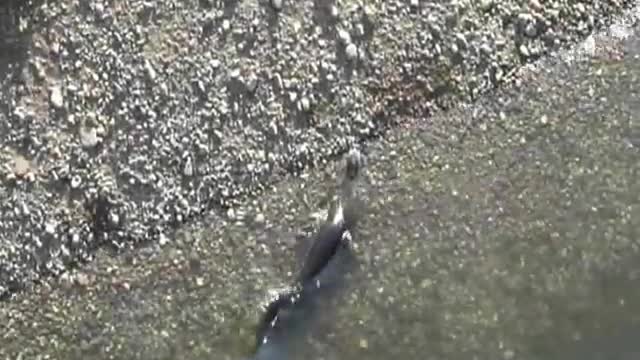Premium Only Content

Catfish grabs pigeon
Extant catfish species live inland or in coastal waters of every continent except Antarctica. Catfish have inhabited all continents at one time or another. Catfish are most diverse in tropical South America, Asia and Africa with one family native to North America and one family in Europe. More than half of all catfish species live in the Americas. They are the only ostariophysans that have entered freshwater habitats in Madagascar, Australia, and New Guinea.
They are found in freshwater environments, though most inhabit shallow, running water. Representatives of at least eight families are hypogean (live underground) with three families that are also troglobitic (inhabiting caves). One such species is Phreatobius cisternarum, known to live underground in phreatic habitats. Numerous species from the families Ariidae and Plotosidae, and a few species from among the Aspredinidae and Bagridae, are found in salt water.
Catfish may have up to four pairs of barbels: nasal, maxillary (on each side of mouth), and two pairs of chin barbels, even though pairs of barbels may be absent depending on the species. Catfish barbels always come as pairs. Many larger catfish also have chemoreceptors across their entire bodies, which means they "taste" anything they touch and "smell" any chemicals in the water.
Catfish have one of the greatest ranges in size within a single order of bony fish. Many catfish have a maximum length of under 12 cm.[5] Some of the smallest species of Aspredinidae and Trichomycteridae reach sexual maturity at only 1 centimetre (0.39 in).
The wels catfish, Silurus glanis, and the much smaller related Aristotle's catfish are the only catfish indigenous to Europe: the former ranging throughout Europe, and the latter restricted to Greece. Mythology and literature record wels catfish of astounding proportions, yet to be proven scientifically. The higher-level phylogeny of Siluriformes has gone through several recent changes, mainly due to molecular phylogenetic studies. While most studies, both morphological and molecular, agree that catfishes are arranged into three main lineages, the relationship among these lineages has been a contentious point in which morphological and molecular phylogenetic studies differ.
Pigeons are also bred for meat, generally called squab and harvested from young birds. Pigeons grow to a very large size in the nest before they are fledged and able to fly, and in this stage of their development (when they are called squabs) they are prized as food. For commercial meat production a breed of large white pigeon, named "King pigeon," has been developed by selective breeding. Breeds of pigeons developed for their meat are collectively known as utility pigeons.
-
 0:11
0:11
ifishidaho
3 years agoIdaho Catfish
5 -
 LIVE
LIVE
Nerdrotic
1 hour agoLet's TACO-bout Take Us North, Hollywood COPE! Cracker Barrel CRACKED! | Friday Night Tights 369
1,561 watching -
 8:37
8:37
Warren Smith - Secret Scholar Society
5 hours agoJesse Lee Peterson EXPOSES How Stupid David Pakman Really Is
1.8K5 -
 44:44
44:44
Scammer Payback
7 hours agoCrazy Confrontation with Hacked Scammer Group
1K1 -
 1:09:00
1:09:00
vivafrei
2 hours agoKamala Harris Security Being "Pulled"? Kilmar Wants Trump Admin GAGGED! Fake News GALORE & MORE!
50K15 -
 1:33:32
1:33:32
The Quartering
4 hours agoContest Winners Picked, More Trans Attacks, SNL Collapsing, Raja Jackson STILL Not Arrested!
184K159 -
 1:19:44
1:19:44
Mark Kaye
5 hours ago🔴 Kamala FURIOUS Over Trump's Latest Move!
18.3K7 -
 LIVE
LIVE
LumpyPotatoX2
2 hours agoSkate: Early Access - #RumbleGaming
58 watching -
 21:14
21:14
Jasmin Laine
2 hours ago“Absolute Nonsense Policy”—CBC Guest DROPS Savage TRUTH! Poilievre LEAVES Reporters SPEECHLESS
10.8K11 -
 LIVE
LIVE
LFA TV
10 hours agoLFA TV ALL DAY STREAM - FRIDAY 8/29/25
1,486 watching